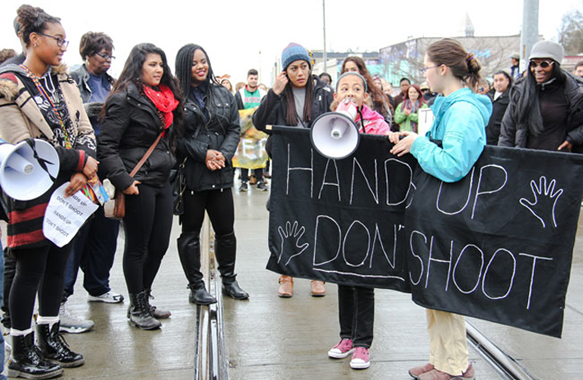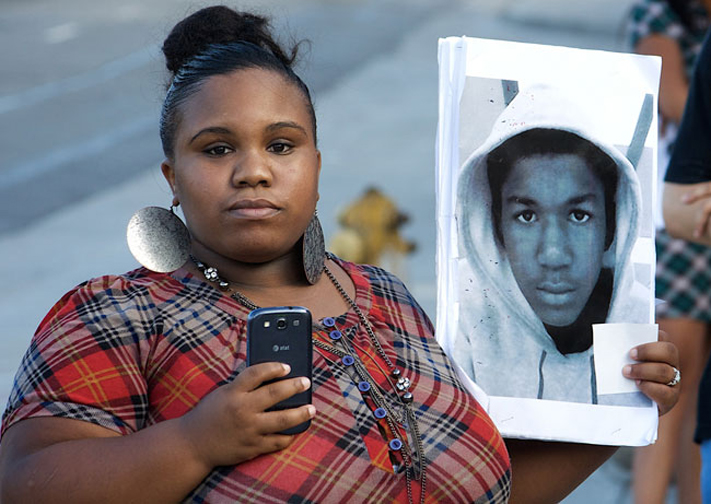By Adrienne Maree Brown | Originally Published at Yes! Magazine. February 24, 2015 | Photographic credit; Millions March NYC, December 2014. By B.C. Lorio.
The people dying are moms and dads, kids and teenagers, nerdy, quiet boys and girls. This movement is showing what wholeness looks like and demanding an uncompromised justice.
We are embodying something different in this movement. It is worth celebrating what is new in how we are living the movement today.
Our generation’s grief is closer to the surface than ever before as we experience—by means of simultaneous spiritual and technological awakening—what it feels like to be collectively aware of oppression on a national scale. We feel the desperate speed with which injustice falls on us, and hold each other through it in physical and virtual spaces. But it doesn’t just feel like we’re being slaughtered—we have the texts, records, reports, and videos to document the rhythm of modern violence.
The “who” matters. The black people who are dying in this racial conflict are not esteemed movement leaders, strategists, voices of dissent, people choosing to practice radical economics, or armed militia. They’re daughters and fathers focused on survival, asking for help, on their way to or from work. Nerdy, quiet boys and girls. Teenagers and children in or near their homes. They’re people who fall outside a guilty or innocent paradigm. Any of us, or our family members, on any given day, could be these people.
Those who have responded don’t fit the traditional mold of leadership either. That relatively young people are leading this movement shouldn’t be a surprise; each generation rolls up like a wave that has never faced the sand and transforms the shoreline. (It is thrilling, I’ll admit, to see mature organizers stepping aside, but still playing the roles of mentor and cheerleader.)

Seattle, December 2014. Photo by Scottlum.
The people showing up to lead this movement are young, and they are black, queer, trans, disabled, poor, middle-class, students. And they’re bringing their whole selves—all of their converging identities—to the movement. To have multiple oppressed identities in this country used to mean learning to create an internal hierarchy where identities vied for the need to be witnessed and loved by the community. Many of us have studied how, in previous movements for liberation in the United States, gender, sexuality, class, ability, and other core aspects of ourselves were routinely diminished, considered controversial distractions when raised.
We are learning ... to grieve in motion.
All black lives matter, every single one. And that truth necessitates a society in which all lives matter: queer, trans, disabled, multiracial, elder, writers, artists, teachers, healers, workers, parents. All of them.
Those who are shaping this movement have in common a practice of saying “yes” to being many things. Yes, we are black, we are queer, we are lovers, we are mamas and daddies and aunties and uncles, we are Asian, we are disabled, we are transgender, we are allies, we are white, we are unlearning and unteaching racism, we are listening, we are transient, we are Arab, we are indigenous, we are immigrant, we are persecuted, we are dying too, we are with you, we are you.
This movement isn’t asking for inclusion—it is showing what wholeness looks like and demanding a whole and uncompromised justice. There is a saying that you have to love yourself first, before others will see how lovable you are. Yes, look at us. We are irresistible.

Rally for Trayvon Martin, July 2013. Photo by Ryan Vaarsi.
Adrienne Maree Brown wrote this article for Together, With Earth, the Spring 2015 issue of YES! Magazine. Adrienne, a contributing editor for YES!, is a writer and activist living in Detroit. She is co-editor of Octavia’s Brood: Science Fiction from Social Justice Movements. She studies somatics and social justice with Generative Somatics and Black Organizing for Liberation and Dignity (BOLD), and was a national co-coordinator for the 2010 US Social Forum.
This piece was reprinted by EmpathyEducates with permission or license. We thank the Author, Adrienne Maree Brown, and Yes! Magazine for their kindness, and contemplation. May we all consider that “love is the language of the movement” and what can be more welcome than love, for self, community and the wholeness that comes when we move together.












Leave A Comment